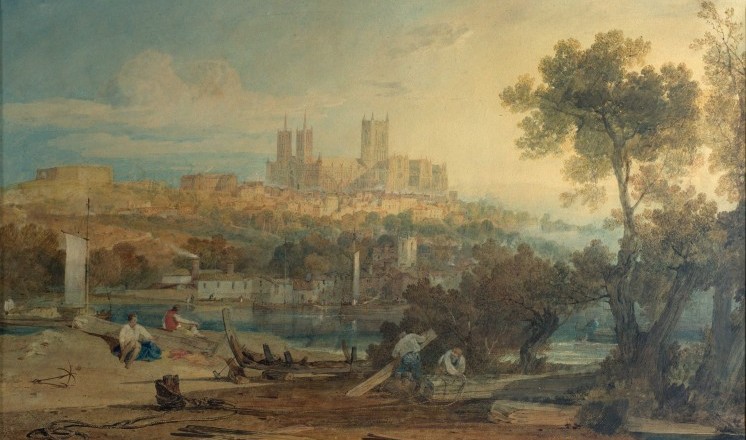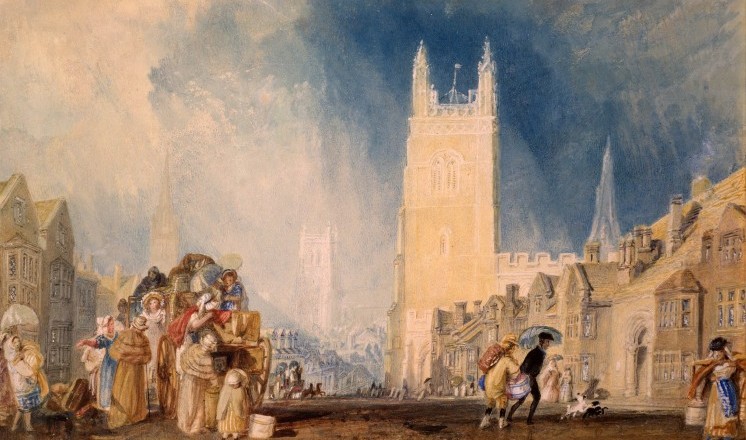90 Years of Collecting | The Usher Gallery at 90: Fourth Decade, Works of JMW Turner
RSS FeedTo celebrate the Usher Gallery's ninetieth year, Dawn Heywood explores the wonderful artworks collected in each decade it has been open.
1957-1966: JMW Turner's Views of Lincolnshire
Topography was an area in which JMW Turner excelled and both of Turner's paintings in the Usher Gallery collection are excellent examples of this oeuvre. Although he visited Lincoln in 1794 and made sketches, he quite freely studied engravings by other artists, such as Samuel and Nathaniel Buck's engraving of Lincoln (1743), as an aide-memoire for his finished paintings.
Lincoln from the Brayford c.1802-3 (bequeathed by the Hon. Mrs Dudley Pelham, 1962) has been described by art historians as one of the crowning achievements of Turner's first maturity. It is a view that many artists, both before and after Turner, have painted, from the Brayford Pool looking up towards the Cathedral. Turner captures the magnificence of the Cathedral whilst bringing a sense of local colour to the canvas. In the foreground we can see two workers on the bank and another two figures sitting close by.
Turner was a great admirer of the work of the great landscape painter Claude Lorrain, and in this painting we see Turner's ability to match the structured classical landscapes of Lorrain's whilst translating it into a typically British scene. The two spires on the west towers of the Cathedral are visible; these were removed in 1807.
The second painting in the Usher Gallery is Stamford, Lincolnshire c.1828 (presented by the Heslam Trust assisted by grants from the NACF and the V&A Purchase Grant Fund, 1966). This magnificent watercolour was produced by Turner for his ambitious print project, Picturesque Views in England and Wales, in association with the engraver Charles Heath. The series of images would be engraved on copper plates and published at regular intervals.
Stamford was the natural place to break a journey by stagecoach on the Great North Road, as it is situated halfway between London and York. Stamford had a number of coaching inns as by 1830 there were 30 stagecoaches and 40 mail coaches passing through each day, and this watercolour shows figures alighting from a North-bound coach and crossing to the Bull and Swan Inn. The view looks down the High Street, and the tower of St. Martin’s Church is shown in bright sunlight against the dark thunder clouds. The atmosphere of the scene is heightened by Turner's adjustments to the angle of the road and the size of the buildings opposite the church. As with the painting of Lincoln, Turner was always interested in including incidents from modern life, and here created a feeling of bustle and energy with the travellers having just alighted from the coach, piles of luggage on the ground and two dogs barking in the street. It illustrates Turner's technical accomplishment and mastery of the medium of watercolour.
The Bailgate Independent is also covering this story in their monthly issue – http://www.bailgateindependent.co.uk/ Out now!
Comments
Some decades ago we were staying with friends at St Martin’s, Stamford, just by Turner’s viewpoints of the town, the artist moving from one side of the street to the other. The view of Lincoln was unaccountably omitted from Andrew Wilton’s Turner catalogue. Was it not connected with the artist’s friendship with the Sibthorp family of Canwick?
Dr Selby Whittingham, Companion of the Clarence Bi

